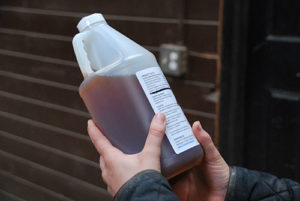Tips for Meeting a Senior Horse’s Nutritional Needs

To begin her talk, Leatherwood noted that active senior horses tend to live the “stall life” and are more intensively managed than other groups of horses.
She said, “This stall lifestyle has a huge impact on the overall health and stability of the digestive tract.”
Specifically, stalled senior horses are often fed forage-based diets with concentrate meals added to improve performance and provide extra calories. Leatherwood emphasized, however, that feeding senior horses requires more finesse than just adding an extra grain meal per day to boost calorie intake.
Leatherwood then highlighted the importance of addressing a senior horse’s intestinal microbiome.
“The intestinal microbiome, which contains billions of microbes, not only helps horses digest but also has the potential to mitigate disease,” Leatherwood said. “The health of this microbiome is extremely important for senior horses, particularly those that may require long-term pharmaceutical use, which many do.”
Feeding high-grain meals and low-quality or insufficient amounts of forage can disrupt the intestinal microbiome, resulting in extensive consequences. Disruption of the cecal microflora (the cecum being the gateway to the large intestine), alterations in cecal pH, and intestinal inflammation are all potential sequelae.
Further, Leatherwood said, “The cells that line the gastrointestinal tract, called enterocytes, can break down during times of stress.”
Enterocytes are essentially glued together by proteins that form tight junctions. When intact, the tightly adhered enterocytes form a barrier between the outside of the horse (which is the inside of the gastrointestinal tract) and the horse’s bloodstream.
“In the face of unhealthy enterocytes, the gut becomes leaky, allowing bacteria or pathogens to translocate into the interstitial space (between cells) that culminates in the release of inflammatory molecules,” Leatherwood explained. “This ‘leaky gut’ results in a localized inflammatory response, which can ultimately cause a systemic inflammatory state in which these chemical messengers enter the horse’s bloodstream and circulate throughout the body.”
A chronic state of inflammation can negatively affect circulating nutrient levels (e.g., the vitamin folate and specific fatty acids).
How To Maintain a Healthy Senior Horse GI System
Leatherwood said providing high-quality feeds formulated for senior horses and making sound management decisions can help owners maintain a healthy gastrointestinal system. After all, as she attested, “healthy gut, healthy horse.”
Leatherwood’s recommendations for feeding senior horses included the following:
- Offer high-quality forage, which is paramount to feeding senior horses and, indeed, should be the foundation of the diet.
“Forage should be the first thing to look at in a horse’s diet, even if we need them to gain weight,” she said.
- Ensure adequate forage is available to meet the horse’s energy demands.
- Avoid starch overload when feeding concentrates.
- Consider offering alternative energy sources.
“When selecting a supplemental concentrate, be aware of the digestible energy sources,” Leatherwood advised. “Instead of common sugars and starch-based energy sources, consider alternatives such as lipids (fats) to support the steady glucose and insulin secretion post-meal.”
- If feeding concentrate meals, remember that a horse has a relatively small stomach compared to the total volume of the gastrointestinal tract. The maximum size of the meal should be 0.5% of the horse’s body weight.
- Consider adding pre- and probiotics, and potentially both (i.e., synbiotics), to the horse’s diet.
“These digestive aids may beneficially impact digestibility, improve nutrient utilization in less-than-ideal diets, and help improve microbial function,” said Leatherwood.
- Allow time for the gastrointestinal tract to adapt to any new diet. Leatherwood said it takes about seven to 10 days for the enterocytes to turn over and become accustomed to a new diet. The cells require an even longer period—four to six weeks—to adjust completely.
Take-Home Message
Owners must consider and address the stability and diversity of the intestinal microbiome, leaky gut syndrome, and inflammation when formulating diets to meet the needs of their senior horses.

Related Articles
Stay on top of the most recent Horse Health news with

















